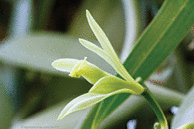
![]()

The vanilla flavor used in ice cream and many other foods comes from a vining orchid that originally grew in Mexico called Vanilla planifolia. A Spanish conquistador discovered the pleasant-tasting flavor used by the Aztecs, and he introduced it to Europe in the 1520s. The Europeans attempted to produce vanilla in their own countries. They were able to grow vines, but the vines produced no fruit.
For three centuries the Europeans depended on Mexico for the tasty substance. In 1836 a French botanist was visiting Mexico and noticed some bees landing on the vanilla flower and working their way under a flap in the flower and becoming dusted with pollen which they transferred to other flowers. Within hours of pollination, the flowers closed and soon seed pods began to form.
The secret of how to pollinate the flowers was known only to those stingless bees of the genus Melipona found only in Mexico. The people who were attempting to grow vanilla elsewhere tried without success to bring the bees into their areas. Then in 1841 a twelve-year-old slave boy discovered a way to hand pollinate the flowers using a sliver of bamboo. That method is still used today and because of that, Indonesia and Madagascar produce more vanilla flavoring than Mexico does. This method of hand pollination is labor intensive and requires constant monitoring of the plants because the flowers stay open for only a few hours.
It took humans 300 years to discover how to pollinate the vanilla flower. Before that, only a special bee knew the secret. Without the bees, there would have been no vanilla plant for humans to discover and use. The vanilla orchid could not survive without the bee. Who put that bee there and told it how to pollinate that flower? We see this as another evidence of God’s creative work.
Picture credits:
© IamTK. Image from BigStockPhoto.com
